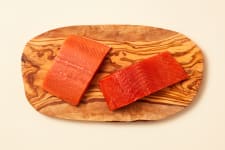Pictured above: ASMI (Alaska Seafood Marketing Institute)’s recipe for Thai-inspired wild Alaska pollock meatballs with sweet potato noodles and almond butter sauce.
If you’ve ever made meatballs from a conventional protein choice, you absolutely have all the skills you need to make meatballs with wild-caught seafood. It’s the same process of combining minced protein — in this case fish — with herbs, spices, seasonings, and binding ingredients like breadcrumbs and egg, with the ultimate goal of forming light, tender meatballs that can be enjoyed in a variety of ways: plain, in sauce, with sauce on the side, by the dozen, however you like to enjoy this fun-to-eat food. Meatballs are also fun to make; without a recipe, you can really flex your creative, culinary muscles to create a customized meal.
We’re going to walk you through how to make wild-caught seafood meatballs at home without a recipe.
Pick a Fish
Are you making meatballs with coho or sockeye? Cod or halibut? Or maybe rockfish or pollock? For seafood meatballs, any of these lean varieties of wild-caught seafood will do. Using sockeye will give the seafood base of your meatballs the most robust flavor, while any of the white-fleshed fish options will leave you with something milder — more of a blank canvas. Keep in mind that you might be able to differentiate one fillet of white fish from another when they’re presented to you whole, but when they’re minced up, it will be nearly impossible to identify which white fish is which.
If using salmon, you’ll want to remove the skin with a sharp filleting knife, since salmon skin doesn’t work well in a meatball. If you’ve never done this before, you’ll find this how-to video helpful. Salmon skin lovers may want to save any scraps of skin to use in a recipe that transforms them into “salmon skin bacon,” like this one from The Kitchn.
Pick a Flavor Profile
After you’ve chosen your fish, think about what kind of flavor profile you are craving and how you can build that profile with herbs and spices. Most seafood meatballs would benefit from having a bit of garlic mixed in, and perhaps something like a tablespoon of minced onions or shallots.
Beyond that though, do you want something that leans toward Mediterranean flavors? If so, you might want to integrate herbs like basil or oregano into your meatball mixture, and perhaps a bit of lemon zest, like this recipe from The Petite Chef. Want something with warm, South Asian flavors? Maybe you’d like to add in some cilantro, minced ginger, and curry paste like Hayden Quinn’s recipe for Thai fish balls. You do you, but avoid adding anything that will make the meatball mixture too wet, as this will result in you needing to add more filler to keep everything intact.
In addition to herbs and spices, you will also need to have a raw egg and breadcrumbs on hand — or something in place of breadcrumbs like panko, almond flour, or crushed up rice crackers. These white fish meatballs in a North African-spiced tomato sauce from Saveur use matzo meal as their “breadcrumb” component.
Integrating a beaten egg into your seafood meatballs will help keep the minced bits of seafood from falling apart, as will breadcrumbs. Both of these ingredients will also help buffer the seafood proteins from one another, preventing the meatball from seizing up into something dense and tough. You want a light, tender meatball, right?
Make Your Mixture
Either using a food processor or very sharp knife, mince your seafood until it’s finely chopped; if you have a meat grinder, you can also run your fillet of fish through that. Don’t overprocess the fish into paste: You want it to have some texture, resembling ground beef.
At this point, you want to season your seafood with salt and pepper and gently mix in your selection of herbs and spices, as well as your binding ingredients. Generally, you want to use one egg for every pound of meat, and about ¼ or ⅓ cup of breadcrumbs. If you’re ever unsure of how much of anything you should be using, you can look to any of the recipes above, or a recipe like these Japanese-inspired salmon meatballs from Edible Alaska to get an idea of what will work.
To ensure your meatballs stay light and tender, don’t overmix your meatball mixture. This is why you want to combine the ingredients gently, just until everything is distributed more or less evenly. At this point, it should be ready to form into meatballs, but if your mixture is too dry to stick together at this point, add in a splash of oil. If it seems too wet, add in some breadcrumbs.
When you’re forming your meatballs, aim for something golf ball-sized, as this will ensure that your meatballs can pick up some color on the outside while cooking through on the inside; any smaller and they may dry before getting browned, while bigger meatballs might remain a bit underdone in the center. If you have the time to do so, we recommend letting your meatballs rest in the refrigerator for about half an hour. This will help the mixture meld together. Pro tip: Coat your hands in a bit of oil to keep the mixture from sticking to them while you’re forming meatballs.
Choose Your Cooking Method
To cook your fish meatballs, you can pan-fry them, bake them, or poach them.
If you want to develop a nice crust on your meatballs, you might decide to pan-fry them until golden brown so that they’re almost cooked through. From here, you could add them to a nearly finished pot of tomato sauce on the stove, simmering them together with the sauce for the final few minutes of cook time.
If you choose to bake your meatballs, you could cook them in a sauce in a baking dish so that everything is bubbling hot when you pull the dish from the oven. Or, arrange the meatballs on a baking sheet covered with parchment paper, drizzling them with some olive oil, to serve alongside a dip like tzatziki. In most cases, 350 degrees Fahrenheit is a good temperature to work with.
You could combine the above methods, browning the meatballs before baking them in the oven, like this recipe from Splendid Table for Greek-style fish meatballs in a mustard dill sauce.
Or, whether you’re pan-frying or baking, try rolling the raw meatballs in breadcrumbs or something like cornmeal so that they’ll fry/bake up into crispy bites.
Additionally, in some cases you might want to poach your seafood meatballs in gently simmering, salted water, until they float to the top (indicating that they’re done). Check out this recipe from Hank Shaw for German-style cod balls with a creamy spinach-dill sauce.






